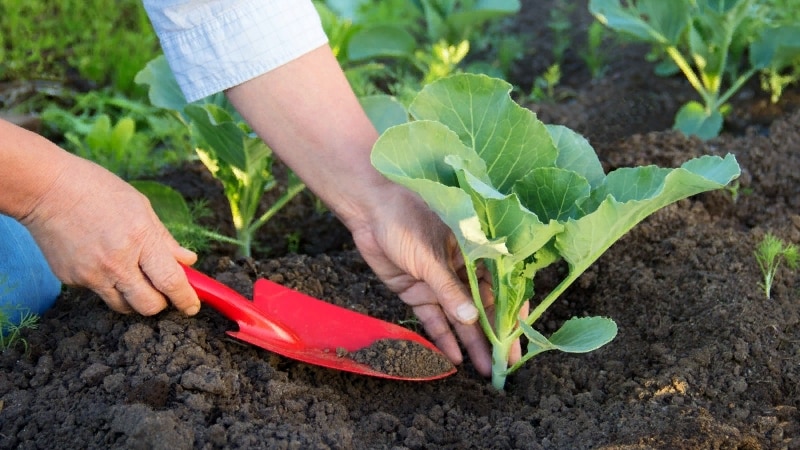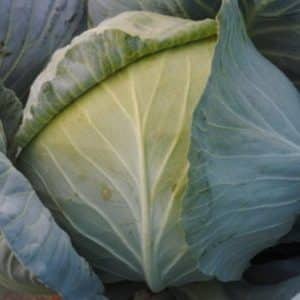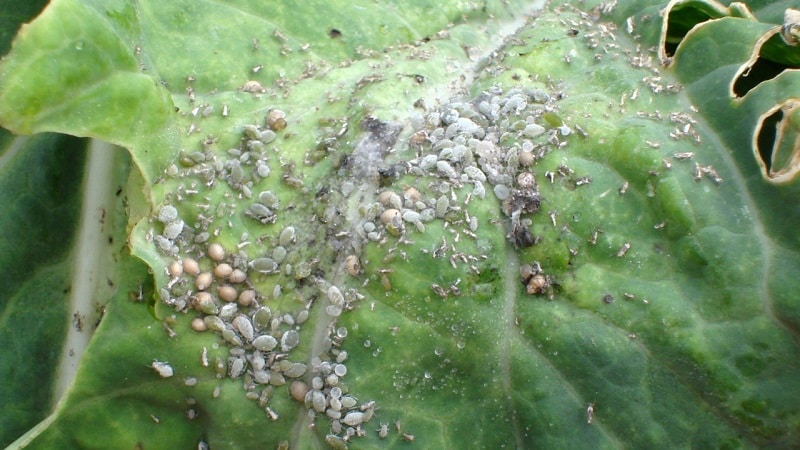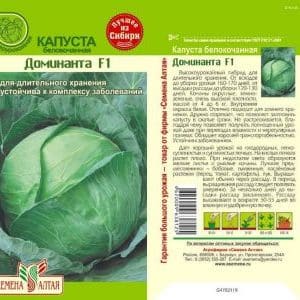Review of the white cabbage variety Dominant f1
The white cabbage hybrid Dominant F1 was developed not so long ago and is not yet widely popular among vegetable growers. Many people still prefer old and proven cultures. But those who nevertheless tried to plant this hybrid on their plot were very pleased with the results. Perhaps you should pay attention to this cabbage and study its characteristics.
What kind of variety is this
White cabbage Dominant F1 is a first generation hybrid. Originator – Moscow “Breeding station named after N. N. Timofeev” at the Timiryazev Academy.
Included in the State Register of Russia in 2011 with a recommendation for cultivation in the North-Western and Central regions, as well as the Volga and Far Eastern regions.
Description and characteristics
Cabbage Dominant F1 is characterized by late ripening - 160-170 days pass from sowing the seeds to the harvest being ready for harvest. Marketable yield – 6-7 kg/sq.m. m in private cultivation and 340-600 c/ha in industrial cultivation.
Reference. The maximum yield was recorded in the Kostroma region. – 688 c/ha.
The plant is a large bush with abundant leaf mass and a raised rosette located on the outer stalk. The leaves of the rosette are blue-green, covered with a waxy coating, rather spreading and have wavy edges. The root system is taproot.
The hybrid is frost-resistant, but this indicator depends on the age of the plant: young seedlings tolerate a short drop in air temperature to -3°C, grown ones - to -5°C, adult cabbage can withstand frosts down to -8°C.
Consumer qualities
The heads of cabbage are round in shape, dense, weighing on average 2-4 kg. The covering leaves are blue-green in color; when cut, the heads of cabbage are white or have a slight cream tint.
Cabbage Dominant F1 has a pleasant taste, contains 8 g of dry matter, 5 g of sugar components and 30 mg of ascorbic acid per 100 g. Ideal for consumption fresh, pickling and long-term storage.
Reference. Having a high density, the heads of cabbage do not crack even in the event of drought and tolerate transportation well.
Advantages and disadvantages of the variety
The main advantages of the hybrid:
- pleasant taste;
- good transportability;
- high productivity;
- resistance to diseases and pests;
- long-term storage;
- simultaneous ripening of heads of cabbage.
Disadvantages of Dominant F1:
- a long stalk, which makes it likely that the heads of cabbage will tip over on their side;
- demands on soil composition.
Features of cultivation
To obtain a high-quality harvest, the conditions for growing the hybrid must be observed:
- the plant needs watering, which should be moderate in the seedling phase and abundant during the formation of heads of cabbage;
- cabbage needs long daylight hours;
- the best predecessors are cucumbers, pumpkin, legumes, zucchini, carrots.
At first, cabbage grows slowly and does not take up much space on the plot, so many vegetable growers practice joint cultivation of this crop with radishes, dill, celery, lettuce or early cauliflower.
Reference. When cabbage is grown together with tomatoes and potatoes, the risk of late blight is reduced for the latter.
Cabbage is planted on the south or southeast side of the site, in a well-lit place, on a hill.
Landing

Seeds for seedlings are sown approximately 55-60 days before transplanting into open ground. More precise dates vary depending on the climatic conditions of the region, but on average it is mid-March or early April.
Before sowing, the seeds, if they have not been pre-treated, are pickled by immersing them in a solution of potassium permanganate or fungicide (Fitosporin M, Alirin-B, Gamair) for 12 hours.
The substrate for seedlings should consist of 75% peat, 20% turf and 5% sand or perlite. Also mix equal parts of garden soil and humus and add 5% sand to this mixture. Before use, the substrate is spilled with a solution of potassium permanganate for disinfection.
Reference. Consumption of soil mixture is 1 liter per 8 bushes.
The seeds are sown on the surface of the substrate, buried by 1.5 cm. After this, the containers are covered with film and put in a warm (+18...+20°C) place until germination. Then the seedlings are regularly watered, fed with complex fertilizers and provided with at least 16 hours of daylight, using artificial lighting if necessary.
14 days before transplanting into the ground, the seedlings begin to harden, gradually lowering the air temperature to +6...+8°C, and when 2 leaves are formed on it, they are transplanted to the site. It is important that the soil is warmed up to +7...+12°C.
Before planting seedlings in the ground, they are watered with a solution of fungicides, and the beds are sprinkled with a mixture of tobacco and ash - this is an additional measure to prevent diseases and pests.
Planting is carried out according to the scheme 60x60 cm, 60x45x50 cm or 70x45x70 cm. Per 1 sq. m. there are 2-4 bushes.
Care

Cabbage is fed at least 3 times per season:
- 10 days after transplanting the seedlings into the ground - organic (mullein or bird droppings) or mineral fertilizers containing nitrogen;
- after 2 weeks – nitrogen-containing fertilizers;
- after the formation of heads of cabbage - nitrophoska, potassium monophosphate or other complex fertilizers that contain potassium and phosphorus.
Water newly planted seedlings every 2 days for 2 weeks, then reduce the frequency of watering, but increase the amount of water. The best option is to use a drip irrigation system.
Reference. Approximately 30 days before the expected harvest, watering is stopped.
The day after watering or rain, the soil is loosened and weeded, getting rid of weeds that take away nutrients. Loosening improves the aeration and moisture permeability of the soil and eliminates the possibility of a dry crust forming on its surface. For the first time, the soil is loosened 10 days after planting the seedlings, the depth of loosening at this time is 7-10 cm, then it is reduced to 3-5 cm.
Simultaneously with loosening, the bushes are hilled, which stimulates the formation of new roots, improves nutrition and increases the plants’ resistance to lodging.
Reference. To reduce the number of weedings and retain moisture, the ground is mulched with straw or sawdust.
Protection from diseases and pests
Breeders managed to create a hybrid resistant to Fusarium wilt, vascular bacteriosis and tobacco thrips. However, if agrotechnical rules are not followed, Dominant F1 cabbage is affected by clubroot, as well as other fungal diseases and pests.
In order to prevent the development of diseases, plantings are treated with fungicides several times a season (Fitosporin, Oksikhom, Abiga-Pik), and in case of pest attacks, the drugs Bazudin (for cabbage flies), Iskra DE, and Iskra-M", "Senpai", "Fufanon", "Inta-Vir", "Knockdown" (from fleas, aphids and caterpillars), "Meta", "Metaldehyde" (from slugs).
Reference. Treatment of cabbage with chemicals is stopped 2-3 weeks before harvest. If necessary, they are replaced with ammonia solution.

Harvest and storage
The harvest is harvested in October or November - it depends on the climate of the region and weather conditions. The main thing is to be in time before the first frost and remove cabbage from the beds on time. If you rush into this, the heads of cabbage will wither during storage, and those that are put away in frost will become soft and rot.
The heads of cabbage are cut with a knife, leaving an outer stalk of 2 cm. Carefully inspect, throw away or set aside for prompt use those that have any damage. Specimens suitable for storage are dried under a canopy, after leaving only 3 covering sheets on them.
Store cabbage in boxes or bags (in this case, the heads of cabbage are wrapped in paper or cling film) in a dark room where the air temperature is -1...+1°C and the humidity is 95-98%. In such conditions, the heads of cabbage retain their quality for 8-10 months.
Reference. The storage room is first disinfected with lime whitewash or fumigated with sulfur.
Farmer reviews
Gardeners who have already tried to grow this cabbage hybrid speak both negatively and positively about it.
Lyudmila, Moscow: «I believed many positive reviews about this cabbage and decided to plant it in my dacha.I didn’t grow the seedlings myself, I was too busy fiddling with them, but I bought ready-made ones at the market and planted them on the plot. The land there is good, fertile, I have planted cabbage in this area more than once before and everything was fine. But not with Dominant F1, unfortunately. I planted 10 seedlings, 6 of them went into leaves and only 4 turned out to be normal. And even then the heads of cabbage themselves disappointed me. Perhaps it’s the seedlings, but I don’t want to experiment with this cabbage anymore.”
Vasily, Kostroma region: “I was pleased with this cabbage. The heads of cabbage are formed large, dense and juicy, the yield is high, and care is simple. I like that Dominant F1 practically does not get sick and is not afraid of pests. The harvest is stored for a long time.”
Maria, Moscow region: “I decided to try some new variety cabbage, a friend suggested Dominant F1. Overall, I liked the experiment - the harvest turned out to be rich, all the heads of cabbage are quite large and beautiful. And this despite the fact that the care was minimal. The harvest was stored for about 8 months, then the heads of cabbage began to wither a little, but I don’t think this is a bad indicator.”
Conclusion
Dominant F1 is a hybrid of white cabbage, obtained thanks to the work of domestic breeders. It is characterized by resistance to most common diseases and pests, high yield, the possibility of long-term storage and ease of care.
